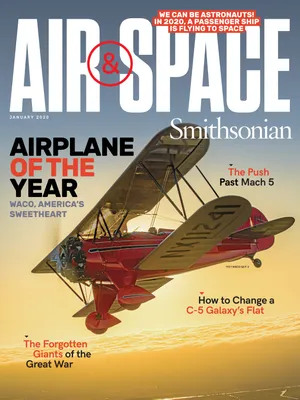Will Space Tourists Finally Get a Ride?
Virgin Galactic has moved into its New Mexico Spaceport. Let the flights begin.
:focal(2636x2115:2637x2116)/https://tf-cmsv2-smithsonianmag-media.s3.amazonaws.com/filer/8b/87/8b871f04-004a-40b6-ad40-6afb6e09bc06/06c_dj2020_virgingalacticwk2_4081_live.jpg)
There’s something flying over Spaceport America on this warm October afternoon, and as usual, it’s not a spacecraft. It’s an Extra 300, owned by Virgin Galactic. Alone in the cockpit is company chief pilot David Mackay, who’s doing tight, descending corkscrews designed to spike the G-forces.
Mackay doesn’t live here in New Mexico—not yet—but his presence here on an ordinary work day indicates the progress Virgin is making toward launching its suborbital space tourism business. Another pilot has relocated to Spaceport America full-time, and a new one is already training.
The test flight team, like the rest of Virgin’s employees at Spaceport America, is preparing for the first commercial operations of SpaceShipTwo and the WhiteKnightTwo carrier airplane that launches it on short hops to the edge of space. “I think we’re making history here,” Mackay says during a stroll through Virgin’s hangar. “We’ve designed two aircraft and a rocket motor for a brand new industry.” The first flight from New Mexico is expected next June.
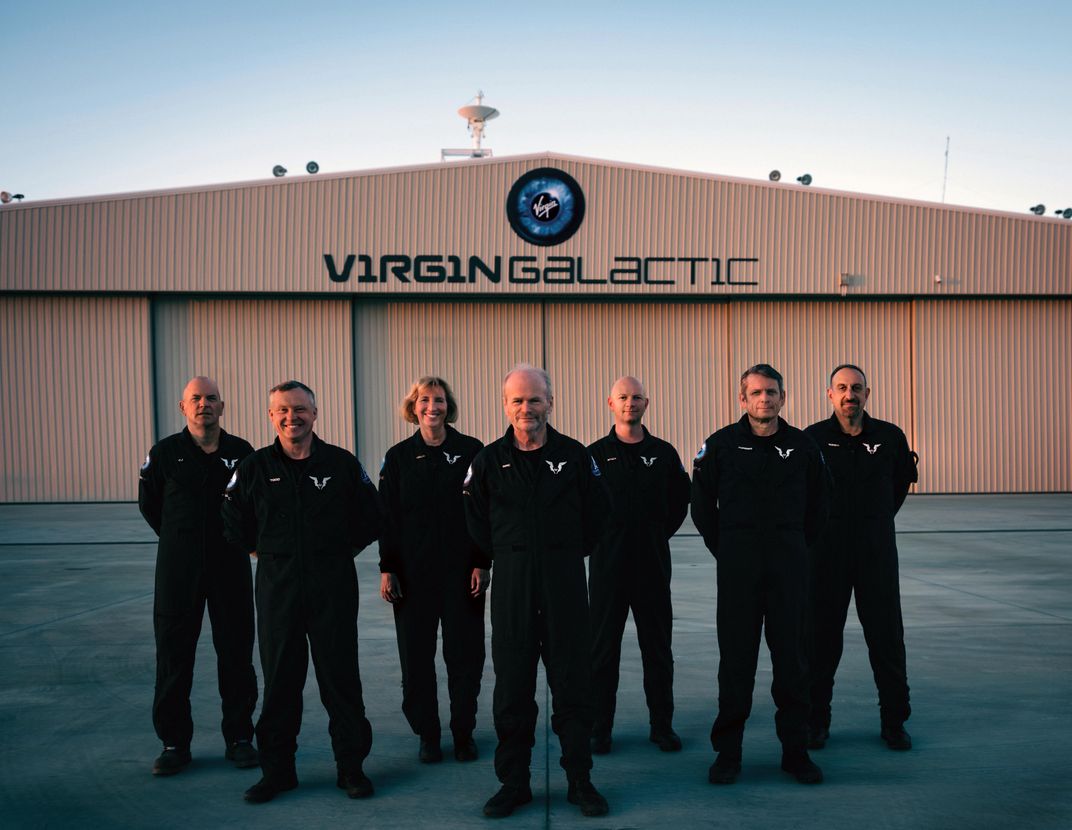
It’s been a long time coming. In October 2009, Virgin Galactic announced that flights from Spaceport America would begin within two years. The facility was declared open in 2011, but that was followed by years of delays and a fatal in-flight accident (there had been another deadly accident on the ground in 2007) as the launch system was under development in Mojave, California.
Residents of two New Mexico counties have chafed at the wait, having voted more than a decade ago in favor of a tax to help pay for the spaceport’s construction. With $209 million of their money already spent on the project, including a $7 million runway extension, the taxpayers have seen little return on their investment so far.
Things started to gear up last May, however, when Virgin founder Richard Branson announced that the company is ready to begin flights as soon as a second SpaceShipTwo vehicle is complete. (VSS Unity is already being used for testing.) “Our Virgin Galactic adventure has been intertwined with New Mexico and Spaceport America right from the start,” Branson told the assembled media. “Today, I could not be more excited to announce that…we are now ready to bring New Mexico a world-first, world-class spaceline.”
Five months later, there’s a real sense of anticipation at this remote, eerily beautiful spaceport. If Virgin’s schedule holds, next summer’s inaugural flight will be a watershed moment for the nascent space tourism business. Ordinary rich people—as opposed to the super-rich who have visited the International Space Station—will routinely be able to buy a $250,000 ticket to space.
Branson has always said he will be the first passenger, a claim he reiterated at an Air Force Association meeting in September. “We’ll do a few more final test flights and then I’ll go up,” he said.
After years of delay that may seem sudden—VSS Unity has flown just 12 times, and only twice to space—but Virgin maintains that the final tests are only needed to validate earlier testing and will go fast. Unity will fly again before year’s end, this time with the passenger cabin fully outfitted. Once the entire launch system is proven to work in its final configuration in Mojave, the pilots will then take several flights to familiarize themselves with flying in New Mexico.
Virgin Galactic’s pilot corps is an accomplished group of aviators that includes commercial pilots like Mackay, former NASA astronaut Rick Sturckow, and U.S. Air Force combat veteran Kelly “Cosmic” Latimer, who later became a NASA research test pilot. Most of the pilots have played a role in developing the vehicles, either with The SpaceShip Company that manufactures them or with Virgin itself.
The FAA will have to sign off on those vehicles before passenger flights begin. Up until now, the company has been granted a license only to fly “non-deployed scientific, experimental, or inert payloads.”
Safety remains a sensitive subject. In 2014, the first SpaceShipTwo experimental vehicle, VSS Enterprise, cracked apart during flight, killing co-pilot Michael Alsbury when it crashed into the Mojave Desert. Investigators blamed co-pilot error and pointed to deficiencies in Virgin’s training procedures, but found no show-stopping problems with the vehicle design.
Branson’s determination to ride to space himself may help replace memories of the crash in the public mind. “I certainly won’t go into space before brave test pilots feel 100 percent comfortable that we’ve checked every box,” he told the Associated Press earlier this year.
During my visit in early October, three technicians in white protective suits are working inside the Virgin hangar on a gangly, twin-fuselage aircraft. It’s a WhiteKnightTwo carrier craft named Eve, which now resides in New Mexico full time. The massive hangar, large enough for three such airplanes, smells faintly of epoxy. “I can’t wait until SpaceShipTwo moves here,” Mackay says.
The Extra is in the hangar as well, and Mackay eyes it eagerly as he speaks. He’s a seasoned front man for the company, but he’s more comfortable in a cockpit, having first flown with the Royal Air Force, then with Virgin Atlantic, and now as chief pilot for Virgin Galactic. Among his other achievements, he piloted SpaceShipTwo during a February 2019 test flight to an altitude of 56 miles, making him the only Scot who has ever been—just barely—to space. (The X-15 rocketplane flew higher in the 1960s, as did SpaceShipOne when it won the XPRIZE in 2004.)
A newly installed flight simulator sits along one hangar wall, nested inside a cupola of dark drapes. A pair of employees in street clothes is testing the simulator’s data connections to operations centers here and in Mojave. Having a high-fidelity sim on the premises is vital to transitioning all training and flight testing to New Mexico. “We are spending less time in Mojave,” Mackay says of the pilots’ workload. “The bias now is being here more, and there less.”
Before long Mackay excuses himself, steps over to the Extra and is soon soaring into the uncommonly cloudy sky. The Gs of the planned suborbital flights don’t peak above a relatively mild 4.2, but these aerobatic flights help keep the pilots conditioned.
Apart from this activity inside the hangar, there are more clues that the long-delayed dream of routine spaceflights over the New Mexico desert may actually be close to happening. The company unveiled its new mission control room and the Spaceport’s customer lounges and other interior rooms in August. In mid-October, it introduced the hip, futuristic “spacewear” designed by Under Armour for VG passengers.
Since last spring, the number of staff here in New Mexico, from pilots to electricians, has tripled. Last year there were only 40 Virgin employees at Spaceport America, but that swelled to 120 this year and should hit 160 next year.
Perhaps the most hopeful sign of progress is slapped to the wall of an office near the empty mission control room: an Aztec pyramid of Post-It notes detailing all the public services needed to pull off a landmark future event. The National Guard, local firefighters, and sheriff’s deputies will all be involved. At the top of the pyramid, one note stands alone: “First Flight.”
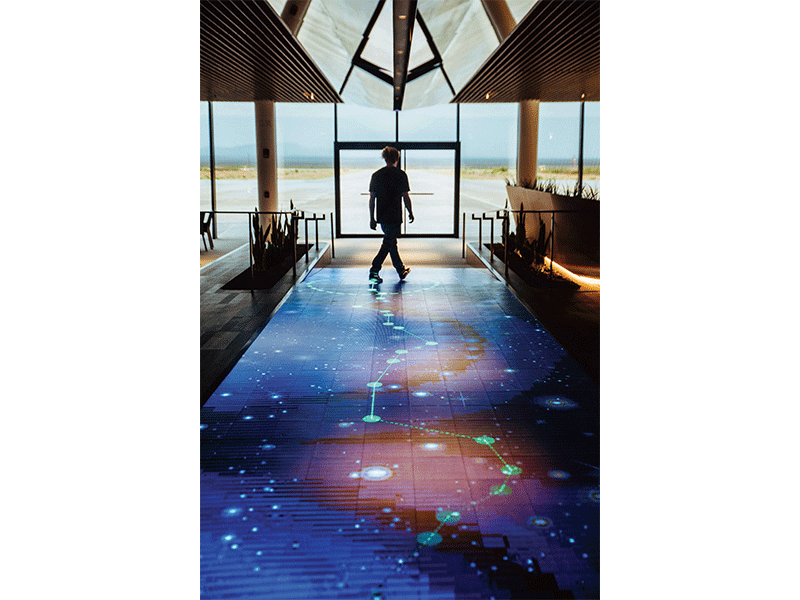
Passengers will walk through the doors, load into a Land Rover and meet SpaceShipTwo on the flight line. The vehicle will be attached to its carrier ship by then. Spectators will have a good view of the runway as the WhiteKnightTwo takes off and circles up to 50,000 feet. From there, the SpaceShipTwo is dropped and ignited like a missile. A 70-second burn gets the spacecraft on a coasting trajectory to 62 miles altitude, which satisfies both of the commonly used (and somewhat arbitrary) definitions of what qualifies as “space”—50 miles and 100 kilometers. The passengers then unbuckle for five minutes of weightlessness before the long glide back down to the same runway. The whole ride, from walkout to wheels stop, takes under two hours.
Back inside the spaceport, the Gaia room’s digitally enhanced walkway cuts through what Virgin calls the “social center” of its operation. The dark, natural tones and sunken seating areas are intended to remind passengers of the Home Planet as they prepare to leave it, according to Brouwer. Today there are a handful of employees ordering coffee from the impossibly pleasant barista working at a backlit, Italian marble island. In the future, Gaia is where customers will congregate between training sessions and for social events, prepare for departure and celebrate their return with champagne. Interaction with staff is encouraged.
“This is hospitality as Richard sees it,” Brouwer says. As general manager of astronaut relations and hospitality for Virgin, he designed these interiors. His experience is in a select niche of the high-end hospitality market, in remote places “where the location, instead of gold faucets, makes the property luxury.” He has managed estates on several private islands, including Branson’s Necker Island (in the British Virgin Island chain).
Now Brouwer is trailblazing an entirely new kind of venture, the world’s first space tourism operation. In filings with the Securities and Exchange Commission (available since Virgin Galactic stock recently became publicly traded), the company describes their target market as “individuals with $10+ million net worth” and a “demonstrated propensity to spend on experiences.”
Virgin is selling more than five minutes of weightlessness, or even five days at Spaceport America, for the quarter-million dollars it charges Future Astronauts. “Having a ticket means being part of a special members club, with special access,” Brouwer says. “I don’t want to say it’s a cult; that’s way too strong, but they do show their passion.”
To keep that passion from cooling during the years of delay, the company has provided ticketholders with tours of the spaceport, run-throughs in simulators, G-flights in the Extra, and meet-ups at solar eclipses. “With a smaller number of people, we have the opportunity to get them more involved,” Brouwer says.
Virgin Galactic’s business plan, as laid out to the SEC, predicts an increasing number of flights as the fleet of vehicles grows. As more people fly, some of the special access will likely fall away, leaving the five-day visit as the core of the experience. Nor will tourism be the only revenue stream. In October, Virgin Galactic and the Italian Air Force signed an agreement to launch scientists doing suborbital experiments. It’s the first time a government agency has reserved a slot for researchers on a commercial suborbital launcher.
The future looks good on paper. Paying flights are projected to start in June with the two existing vehicles: Eve carrying VSS Unity. A second SpaceShipTwo vehicle will enter service in 2020, and a third in 2021. These are already under construction in Mojave. As the fleet expands, the number of customer flights will gradually scale up, building toward five flights a month in 2022.
In the SEC documents, Virgin projected a $104 million loss in 2020, but expects to break even in 2021. By 2023, it expects $274 million in annual earnings, with big profits on each flight. Assuming five of six passenger seats are filled on every flight, that’s $1.25 million in revenue. Operating costs—$121,000 in rocket motor and fuel, nearly $200,000 in customer service and insurance, and another $118,000 in flight operations—leave $820,000 per flight.
Each SpaceShipTwo will be expected to perform five flights per month; the WhiteKnightTwo carriers are each good for 15 monthly flights. At that rate, the Virgin Galactic pilots would be flying every two or three days. According to Mackay, compared to an airline pilot’s schedule, “This is not a particularly stressful job.”
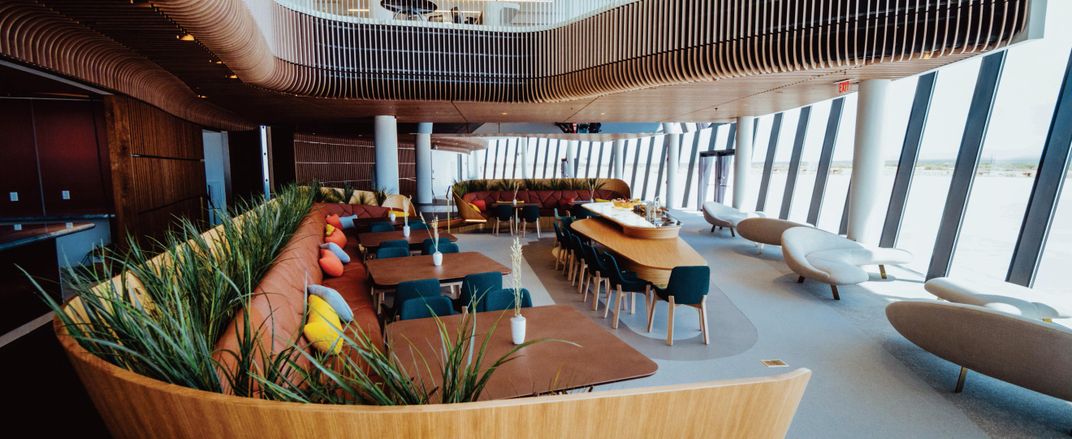
David Bushman scrutinizes one of the spaceport’s concrete launchpads, looking for blemishes on its smooth surface. There’s an ocean of desert around the 98-foot by 98-foot slab, originally built by SpaceX and left unused when that company decided to test its flyback boosters in Florida instead.
Spaceport America assumed ownership of the site and now rents these and other pads to any company that needs the concrete and elbow room to test something dangerous, secretive, or loud. Bushman says his “aerospace engineer” job title should really be “spaceport engineer.” He’s wandering around like any landlord inspecting a property after tenants have moved out. In this case, it’s the smallsat launch company ABL Space Systems, who tested some rocket engines on the slab.
Bushman pauses and aims his phone camera at a pair of bolts rising from the concrete. “These are supposed to be taken off,” he says. “We’ll fix the pad and send them the bill.”
Until recently, this was the day-to-day business of Spaceport America. The operators spent the lean years waiting for Virgin by providing launch range services to companies large and small. Boeing has tested its Starliner crew capsule on high-altitude drop tests; aspiring smallsat launchers UP Aerospace and EXOS are tenants; SpinLaunch, another startup, is testing designs in the spaceport’s Advanced Technology Area; and various industry hypersonic programs have conducted tests here.
Now the place is switching from this odd-job culture to focus on the primary tenant, who’s finally started to move in. “I believe I’m part of the ramp-up,” says Bushman, who left the Dream Chaser spaceplane program at Sierra Nevada last year to join the Spaceport America staff.
Frank Dominguez is an electrical technician who came to work at the spaceport after a decade building gas stations. Now he’s refueling and tending to airplanes, sharing the workload with a multi-tasking maintenance staff that’s more than doubled this year to five. “I never thought I’d be doing this,” he says happily.
The desert surrounding Spaceport America may make it a good place to test rockets, but it doesn’t do Dominguez any favors. “If we need a fuse, we don’t just have it on hand at a store,” he says. “It’s an hour away, so stocking is hard.”
Most new horizontal-launch spaceports—typically existing airports licensed by the FAA—tout their access to existing supply chains and a nearby labor force. But Spaceport America is banking on the idea that its remote location is a plus.
The really valuable real estate here is not underneath your feet but overhead. Look on any map of air traffic over the United States and there will always be a gap over New Mexico, right where Spaceport America sits. The spaceport has access to 6,000 square miles of restricted airspace controlled by its neighbor, the U.S. Army’s White Sands Missile Range. By agreement with the military, Spaceport America officials can open up parts of the government’s restricted airspace very quickly.
This ability to launch and land at will is a critical argument for the Spaceport’s existence. The advantages are real: No overhead airline traffic, no competing for launch windows, no crowds of gawkers watching proprietary experimental spacecraft during testing. And no chance of collateral damage if things go kinetically wrong.
Even after Virgin Galactic is up and running, spaceport managers envision that customers will continue to use its launch areas. “Some companies want to be entirely mobile, and just bring in everything themselves,” Bushman says. “Some want a concrete pad and buildings, others just need a flat spot in the desert.”
Diversity, to a spaceport, is job security, and the operators have their sights set on other emerging industries. Bushman sees an opportunity in space landings, relying on the airspace restrictions and empty expanse of desert to make it an ideal place for science satellites and other fast-moving payloads to return.
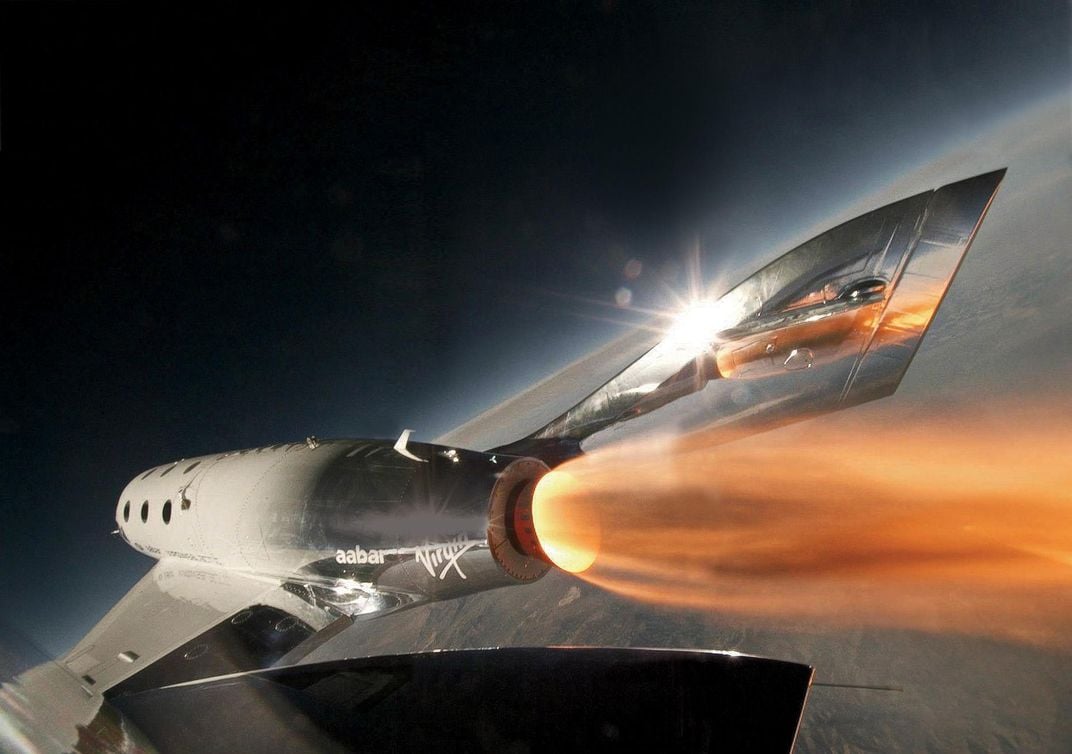
/https://tf-cmsv2-smithsonianmag-media.s3.amazonaws.com/filer/e8/31/e831939c-babc-473c-9246-005acc402eff/06a_dj2020_chiefastronautinstructorspace_live.jpg)
“We don’t have to go straight up and down,” says Mackay, the former Virgin Atlantic pilot. “We would need a new spacecraft, because this one isn’t designed to do it, but it could be a starting point. And once you have high-speed, point-to-point, it’s not that big a step to get into orbit. And that opens up even more possibilities.”
Ironically, talk of spinoff ventures points to a vulnerability in Virgin’s plans. Space tourism isn’t the biggest of markets, and everyone’s aware it’s a gamble. “It takes a lot of positivity,” Mackay admits.
But the dozens of staffers now unpacking boxes and setting up offices in Spaceport America hold on to their belief that something great is happening here. The countdown clock is running, and the day that Virgin Galactic’s space tourism business either rises or falls is coming. The final verdict will be delivered in the skies over central New Mexico, and we’re all invited. With a $250,000 ticket in hand, of course.
